 | |||
|
| Home > Public Information > ING Annual Reports > 2004-2005 > Operation, Maintenance and Developments |
Previous: Scientific Highlights | Up: Table of Contents | Next: Use of Observing Time and Scientific Productivity
Other available formats: PDF
Operation, Maintenance and Developments
Telescope Operation
During the two-year period 2004/05 covered by this report, the ING telescopes
again performed very well, with downtime figures due to technical problems
averaging only 2.3% and 1.5%, on the William Herschel Telescope (WHT) and
the Isaac Newton Telescope (INT), respectively. These figures are well below
the target value of a maximum of 5 percent technical downtime. Observing time
lost due to poor weather over the same period averaged 34%.
Day-to-day telescope operations support is carried out by a dedicated Operations
Team, taking responsibility for the telescopes and associated infrastructure.
Efforts of day-time and night-time support activities concentrate on the WHT.
On this telescope five common-user instruments are supported, one of which
is the complex adaptive optics suite. Also several visiting instruments were
supported at the WHT. Many observing teams visit the telescopes every year.
The INT, in contrast, operates in a much simpler fashion and is a single-instrument
facility. The 1-m JKT does not host science observations anymore, but is now
regularly being used for measuring the atmospheric turbulence profile above
the observatory using the technique of SCIntillation Detection And Ranging
(SCIDAR) led by the IAC.
At night a telescope operator in always present on the WHT to assist the scientists
in taking the observations. ING’s team of astronomers acts as the primary
contact for visiting scientists. They assist visitors in taking the observations
and in carrying out observations in service for the community.
The year 2005 marked the end of an important reorganisation that was the result
of a phased reduction of operating cost of the observatory. These measures
unavoidably had an impact on the service delivered to the visiting astronomers,
but the strong focus on the operation of the WHT has meant that a continued
high level of service and flexibility could still be offered to the community
of users.
Adaptive optics observations are gradually becoming more important. The advent
of the laser guide star system in the near future will drastically enhance
the scientific potential and hence likely increase the interest in the use
of adaptive optics further. In order to ensure optimal scientific use of the
best seeing periods for adaptive optics observations the observing programme
at night must be of a flexible nature. The expectation is that during certain
periods of the year the WHT will be operated in such queue-scheduled mode.
The presence of the Isaac Newton Group of Telescopes at the Spanish Observatorio
de Roque de los Muchachos (ORM) is secured under international agreements.
These agreements will be up for renewal around the turn of the decade after
having been in force for 30 years. Leading up to this date discussions between
the various international partners are under way on how best to adapt and
continue with the formal structure in order to prepare the wider observatory
for the future. In parallel with these discussions, ideas have further matured
on potential further collaboration between telescope groups at the observatory,
building on the successful collaboration that already exists with the Italian
3.5-m Telescopio Nazionale Galileo (TNG).
Together with the international agreements also the telescope facilities advance
in age. One of the first telescopes at the ORM was the INT. In February 2004
that telescope had been in operation on La Palma for 20 years. An impressive
period of two decades of continuous operation that has resulted in many important
discoveries and well over 1100 papers published in scientific journals.
Instrumentation
An important development for the WHT was the commissioning and first science
operation of the intermediate resolution IR spectrograph and imager, LIRIS,
that was built by the Instituto de Astrofísica de Canarias. This instrument,
based on a 1024 by 1024 pixel Hawaii array detector operates in the Cassegrain
focus of the telescope and allows high quality imaging and multi-object spectroscopy
at near IR wavelengths. Following extensive testing LIRIS was taken into operation
during the summer of 2004 as a common-user instrument. The science projects
carried out with this instrument are diverse and include distant galaxies,
stellar populations, brown dwarfs and planetary nebulae, showing the potential
of this instrument for the community of users. In particular the possibility
of using multi-object masks offers a potential that is currently a rare feature
at other telescopes.
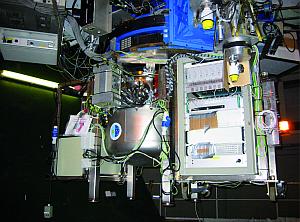 |
Since its commissioning LIRIS has become one of the most popular instruments on the WHT. Its multi-slit mask mode is particularly popular as it offers a huge multiplex advantage over classical long-slit spectroscopy and is therefore very efficient. Many spectra of for instance galaxies in distant clusters can be observed at the same time. Also during the year the polarisation module was commissioned in LIRIS, offering imaging polarimetry at infrared wavelengths.
Development work at the ING has focussed on the Adaptive Optics (AO) instrumentation suite, an extensive and rather complex set of instruments that permanently occupies one of the Nasmyth foci at the WHT. The Adaptive Optics system itself, NAOMI, has been in operation for four years now. It feeds three science instruments: the infra-red imager INGRID, the coronagraph OSCA, and the optical integral field spectrograph OASIS. The latter is the most recent addition to the AO capability through a collaboration with the Observatoire de Lyon, France.
The OASIS adaptive-optics assisted integral field spectrograph was taken fully into operation during the reporting period. The spectrograph works in the optical wavelength range and offers a wide variety of spectral modes. Also optical imaging can be conducted with this system, and best images achieved so far have been those of a close binary system, achieving 0.1 arcsecond image width in the I band.
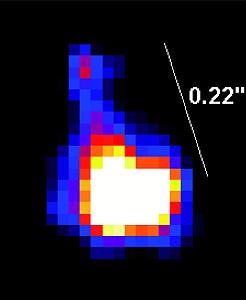 |
The OASIS spectrograph supports a wide choice in bandwidth and resolution. OASIS competes for photons with the wavefront sensor, and in order to have the best possible throughput to both OASIS and the wavefront sensor a range of dichroic beam splitters is available to pre-select the wavelength range of interest. The dichroic reflects the appropriate waveband into OASIS while the remaining photons are used for wavefront sensing. Until recently manually changing dichroic filters posed a significant operational overhead, and therefore an automated system was designed and built to swap dichroics in and out of the beam in a fast, accurate, and efficient manner. This dichroic changer was commissioned during the reporting period and is currently in full operation.
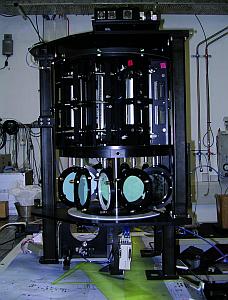 |
Natural guide star adaptive optics is largely limited by the availability of stars bright enough to measure the wavefront distortions on that are induced by the Earth’s atmosphere. Measurement and correction of the wavefront distortions has to take place in the shortest possible time in order to generate the best results. However, short exposure times (milliseconds) also imply that few photons are available and hence bright stars are required to generate sufficient signal-to-noise. Also in the case of NAOMI this is a limitation for effective and broad scientific use of the instrumentation. Being able to detect fainter stars would help ease the situation. At very faint signals the detector read noise becomes an important factor, and therefore a project is under way to install a zero-read noise CCD in the existing wavefront sensor. For faint guide stars the nearly zero read noise from this new detector is expected to improve the detection efficiency of the system by at least a factor of two.
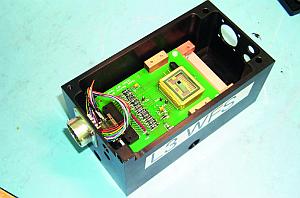 |
The ultimate solution for finding bright enough guide stars is to create an artificial ‘star’ that can be used as a wavefront sensor source. Such artificial source can be created using a strong, well collimated laser beam that is aligned with the main telescopes. Laser light that is back scattered from high in the atmosphere can then be used as an artificial point source suitable for wavefront sensing. In 2004 a project was initiated to create such laser beacon based on Rayleigh back scatter from an altitude of about 20km above the observatory. This project, listening to the Dutch acronym GLAS, for (translated) Ground-layer Laser Adaptive optics System, will work in conjunction with the NAOMI instrument as well as with the existing science cameras.
The scientific advantages of GLAS are potentially huge as such a laser guide star system will amplify the fraction of sky available to adaptive optics observations at visible and infrared wavelengths from a few percent to nearly 100%. In terms of astronomical research, this translates into radical progress as it opens up high spatial resolution observations from the ground to nearly all types of science targets, making possible the observations of faint and extended sources, and enabling observations of large samples, unbiased by the fortuitous presence of nearby bright stars. In combination with the existing instrumentation the WHT will offer a highly competitive facility to the astronomical community, exploiting a window of opportunity before similar capability will exist on 8-m class telescopes.
The system design of GLAS was fully completed in 2005. At the heart of the system will be a 515nm green laser of about 30W. This laser will be mounted at the top of the telescope. Its light beam will travel to the centre of the telescope, behind the secondary mirror, where it will be injected into a beam launch telescope. There the laser beam will be expanded to about 35cm, and subsequently projected into the atmosphere where it will be focussed at a distance of 20km. The diagram below gives a good impression of what this part of the system will look like once installed at the WHT. Expectation is that the laser system will be commissioned in 2006.
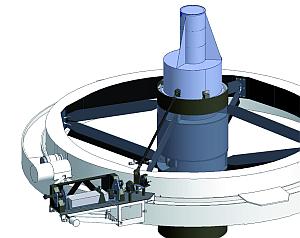 |
|
Figure 35. Top ring of the WHT, with shown in the
front the laser unit inside a cradle. Laser light will travel through
an evacuated pipe to the centre of the telescope, where it will be
projected into the atmosphere by the beam launch telescope that is
located behind the secondary mirror [ JPEG
| TIFF ].
|
Existing instruments remain competitive through the continuous upgrade and improvement of its components. Therefore, apart from the major new instrument developments mentioned above, there have also been a wide range of enhancements to instruments, all with the aim to improve the scientific capability and operational efficiency. An important milestone was achieved with the successful commissioning of the WYFFOS long-camera. This new camera to the fibre-fed WYFFOS spectrograph has the advantages over the original camera that it accommodates a larger number of fibres, has an external focus permitting change of detector, and provides a somewhat higher spectral resolution than the previous camera. The camera was built by the ASTRON institute in the Netherlands.
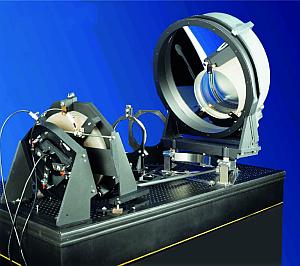 |
Apart from the hardware changes for the WYFFOS instruments, there have also been very significant upgrades of the software. In particular the software responsible for setting up the multiple fibre module, AUTOFIB, that feeds WYFFOS has seen major modernization, resulting, amongst other things, in a drastic reduction of the fibre setup time.
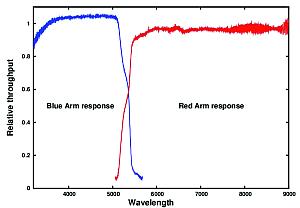 |
Also the venerable ISIS spectrograph has seen important advances with the acquisition of a new dichroic filter that splits light between the red and blue optimized spectrograph arms. The new dichroic possesses a sharper cut between the wavelength ranges at a wavelength that is appropriate for most science programmes, and also features a smoother response. A small but very significant upgrade that has helped the efficiency of the instrument as a whole.
The WHT remains very popular with university groups who build dedicated instruments to find answers to specific astronomical questions. The infrastructure and support offered by ING greatly assists the exploitation of visiting instruments. For that reason over the years many instruments have been deployed in this way and during the reporting year no less than six different visiting instruments came to the telescope. New instruments that had not been to the WHT before were the CIRPASS multi-object IR spectrograph and PLANETPOL, capable of extremely high accuracy polarimetric observations. A brief description of these two new visiting instruments follows.
CIRPASS is a near-IR fibre-fed cooled spectrograph, designed and built by a team from the University of Cambridge. The acronym stands for the Cambridge Infra-Red Panoramic Survey Spectrograph. CIRPASS can take either an integral field fibre bundle or a multi-object fibre bundle. The latter was used at the WHT. A plug-plate system of pre-drilled holes allowed the acquisition and observation of many galaxies simultaneously, thus providing a huge multiplex advantage. The observations focussed on the star formation rates in distance galaxies such as those found in the Hubble Deep Field.
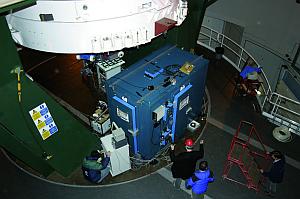 |
The second visiting instrument new to the WHT was PLANETPOL, from the University of Hertfordshire (UK). The key objective of this instrument is to detect and characterise scattered light from planets around distant stars. Starlight scattered on the surface and in the atmospheres of extra-solar planets causes a weak but characteristic polarization signal. PLANETPOL is designed to detect such very weak signals and has already proven it can achieve that demanding goal.
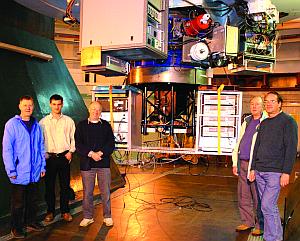 |
The WHT also keeps attracting experimental activities. Arguably the most exciting set of experiments relate to the future development of extremely large telescopes. The future telescopes will have segmented primary mirrors and a very significant and costly problem is the control of the segments in order to keep them aligned at all times to a fraction of a wavelength. Of course this problem has been solved by existing segmented telescopes such as the Keck twins on Hawaii and the GTC on La Palma, but for future ELTs the problem is much more severe and costly. Therefore alternative methods are being considered to determine the phase difference between the segments by optical means, in a fast way, and by using starlight. The results of such measurement can then be used to mechanically control the relative position of the mirror segments.
Theoretical work by the group in Arcetri, Italy showed the feasibility using a novel technique of the pyramid wavefront sensor, but this required testing under real conditions as proof-of-concept. This idea inspired collaboration with groups from Durham, UK to use the deformable mirror of the NAOMI adaptive optics system which happens to have individual segments that can be controlled, thus serving as a tiny prototype of a future giant telescope. The experiments were very successful and have proven that the concept is indeed viable.
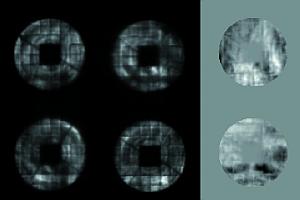 |
Another very successful experimental activity that was hosted by the ING falls in the field of astronomical site characterization. In past years researchers from the University of Durham had developed a novel method to measure atmospheric turbulence. This method of Slope Detection and Ranging, or SLODAR, had been extensively tested on the WHT and was so successful in measuring turbulence profiles in the lower atmosphere that a portable unit was designed. This unit would be deployed at different observatories as a site testing tool in preparation for the future construction of extremely large telescopes. First tests were carried out on La Palma, hosted by the ING.
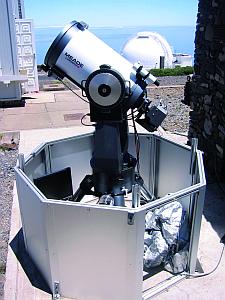 |
Infrastructure
The LIRIS IR spectrograph was commissioned during the reporting period. LIRIS, being a complex cryogenic instrument, requires particular care also when it is not mounted on the telescope. For that reason a dedicated 'parking' area was constructed in the basement of the WHT. In this enclosure the instrument can be kept cold and connected to the network and ancillary equipment for monitoring and control. Furthermore, a mobile, deployable clean room has been acquired that can be installed in the aluminizing area. The prime purpose of this acquisition was for LIRIS in case the instrument needs to be opened up, but it will be equally useful for similar operations on other instruments.An important milestone was reached with the full modernization of the detector controller infrastructure. Not only the science detectors, but also all TV and autoguider systems now operate on the basis on SDSU controllers while data acquisition runs through ING's ULTRADAS software system. Having a uniform infrastructure for these systems offers significant advantages for maintenance, while at the same time performance of these modern systems is much better.
Steady progress was made on installation of a higher bandwidth data link between the Mayantigo office building at sea level and the observatory site, culminating in an order-of-magnitude enhancement. Also the connection of the observatory to the Internet improved drastically. This improvement has meant, amongst other things, that archiving of scientific data in Cambridge is now automated and does not require posting of tapes or disks anymore.
Over the years ING has been making steady progress in tracking and implementing the latest CCD detector technologies. Activities include the use of low-light-level CCDs for wavefront sensing as well as for high speed spectroscopy, optimized coatings to reduce fringing at long wavelengths, and testing of surface treatment techniques also to reduce fringing.
A low-key activity has been the step-wise improvement to the WHT control room, in order to make it a more friendly work environment, including new furniture, additional possibilities for computer connections, and improvements in lighting, computer screens and insulation from the somewhat noisy electronics cabinets.
During the reporting period both the INT and WHT primary mirrors were re-aluminized. Also mirrors from partner telescopes at the observatory make use of INGs experience and infrastructure. The past two years both the mirror of the Nordic Optical Telescope and of the Liverpool Telescope were aluminized by INGs team.
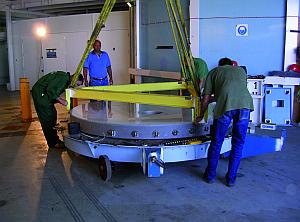 |
Early in the reporting period the SUPERWASP experiment, led by the Queens University Belfast and hosted by the ING was officially inaugurated. The installation consists of a number of wide-field cameras on a robotic mount, located in an automatic roll-off roof enclosure. The main scientific aim of this experiment is the detection of planets around stars through their occulting effect when the planet transits the stellar surface. The inauguration event was carried out, very appropriately, by remote control; the mayor of the municipality of Garafía where the observatory is located, Mr. José Peñate, commanded the instrument to move and cut a red ribbon.
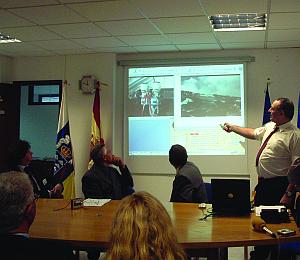 | 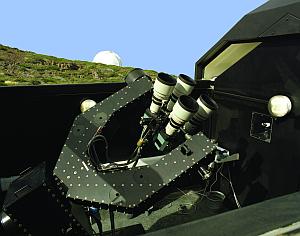 |
| Top | Back |
|

